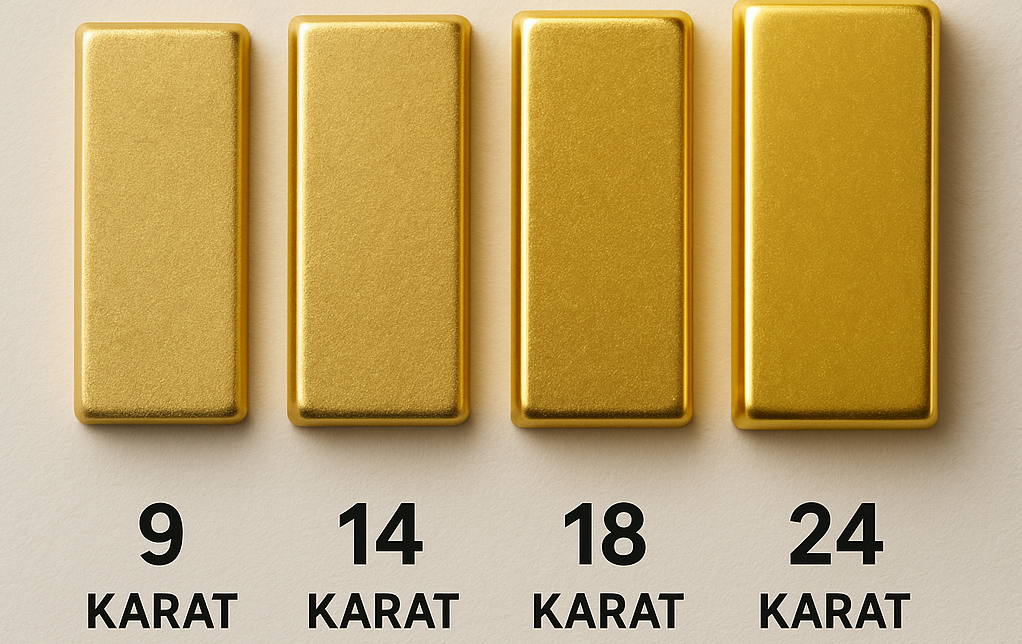Gold has been cherished for centuries for its beauty, rarity, and value. But not all gold is created equal. When you buy or sell gold jewellery, you’ll often hear terms like “9 karat” or “18 karat.” These numbers don’t just indicate value—they refer to the purity of gold and the types of alloys mixed with it.
In this article, we break down the different karat grades of gold—from 9K to 24K—and explain what alloy mixes are used in each, as well as their colour, strength, and common uses.
What Does “Karat” Mean?
The term karat (K) measures the purity of gold on a scale of 24. Pure gold is 24 karats, meaning it is 99.9% gold. Lower karat numbers indicate that the gold has been alloyed with other metals such as silver, copper, zinc, or palladium to improve strength, adjust colour, or reduce cost.
Gold Karat Ratings and Alloy Compositions
24 Karat Gold (99.9% Pure Gold)
Gold Content: 999 parts per 1,000 (99.9%)
Alloy Mix: None or trace elements only.
Colour: Bright yellow
Properties: Soft, malleable, and not ideal for everyday jewellery.
Common Uses: Investment-grade gold, coins, bullion bars, and ceremonial jewellery.
22 Karat Gold (91.6% Pure Gold)
Gold Content: 916 parts per 1,000 (91.6%)
Alloy Mix: Typically copper or silver
Colour: Rich yellow
Properties: Slightly harder than 24K but still relatively soft; may wear down with daily use.
Common Uses: High-end jewellery in India, Middle East, and Asia
18 Karat Gold (75% Pure Gold)
Gold Content: 750 parts per 1,000 (75%)
Alloy Mix: 25% other metals, typically copper, silver, or palladium
Colour Variants:
Yellow Gold: Mixed with silver and copper
White Gold: Mixed with palladium or nickel and often rhodium-plated
Rose Gold: Mixed with copper for a reddish hue
Properties: Durable, luxurious, and suitable for fine jewellery
Common Uses: Engagement rings, high-quality watches, luxury items
14 Karat Gold (58.5% Pure Gold)
Gold Content: 585 parts per 1,000 (58.5%)
Alloy Mix: 41.5% other metals, such as copper, silver, zinc, or nickel
Colour: Slightly lighter yellow than 18K; available in white and rose gold as well
Properties: Harder and more resistant to scratching; still maintains a good gold appearance
Common Uses: Everyday jewellery, wedding bands, chains
10 Karat Gold (41.7% Pure Gold)
Gold Content: 417 parts per 1,000 (41.7%)
Alloy Mix: 58.3% metals such as copper, silver, zinc, or nickel
Colour: Pale yellow; can appear duller than higher-karat gold
Properties: Very hard and durable, less expensive
Common Uses: Budget-friendly jewellery, class rings, fashion accessories
9 Karat Gold (37.5% Pure Gold)
Gold Content: 375 parts per 1,000 (37.5%)
Alloy Mix: 62.5% other metals, often copper and zinc
Colour: Light yellow, can also be found in white and rose tones
Properties: Extremely durable and affordable, but less ‘gold-looking’
Common Uses: Widely used in the UK and Australia for accessible, hard-wearing jewellery
Choosing the Right Karat for Your Needs
Higher Karats (22K–24K): Best for collectors or ceremonial jewellery. These are less suited for daily wear due to softness.
Mid-range Karats (14K–18K): Perfect for most people who want a balance between beauty and strength.
Lower Karats (9K–10K): Ideal for everyday pieces or those on a budget. They offer excellent durability with a more subdued gold appearance.
Why Alloys Matter
The alloy metals added to gold affect not only durability, but also colour and price:
Copper: Adds strength and creates rose or reddish gold
Silver: Lightens the gold colour
Zinc: Helps prevent tarnish and improves hardness
Palladium/Nickel: Produces white gold, though nickel may cause skin irritation
Understanding gold purity and alloy compositions helps you make smarter choices—whether buying a sentimental piece or selling old jewellery. If you’re unsure what karat your gold is, visit a professional buyer like GoldCompany, where our team can test, value, and offer you the best price based on the purity and weight of your gold.


Comments are closed